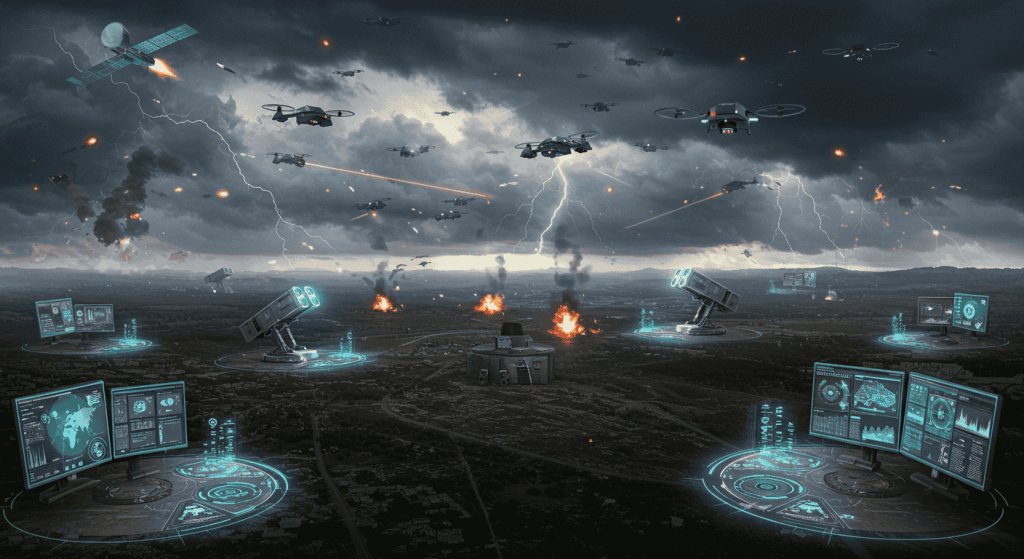Introduction: Europe’s Strategic Defense Shift in 2025
In 2025, European nations are undergoing a technological transformation in their military strategy. With rising geopolitical tensions and emerging global threats, the focus has decisively shifted toward advanced European defense technology. Countries across the EU, led by France, Germany, and the UK, are collaborating through NATO and national initiatives to bolster their defense infrastructure with cutting-edge innovations.
Below, we explore the top 5 defense technologies Europe is investing in 2025, examining their impact, potential, and strategic value.
1. Military AI Systems and Autonomous Decision-Making
Revolutionizing Battlefield Intelligence
Europe is investing heavily in military AI systems to automate decision-making, data processing, and real-time threat assessment. These systems are now central to NATO-aligned strategic defense efforts, especially in rapid response operations.
Key Features:
-
AI-based threat detection
-
Automated logistics and battlefield mapping
-
Predictive analytics for cyber and missile threats
Example Initiative: France and Germany’s joint “Future Combat Air System (FCAS)” integrates AI-powered combat platforms.
Why It Matters:
AI-driven solutions allow faster decisions with fewer human errors, enhancing both operational efficiency and troop safety.
Trending Now: RockYou2025 Password Leak – What You Need to Know
2. Hypersonic Missile Defense Capabilities
Intercepting the Fastest Threats on Earth
As Russia and China advance in hypersonic weaponry, Europe is working with NATO to develop hypersonic missile defense systems that can detect, track, and neutralize threats traveling at Mach 5 or faster.
Technologies in Use:
-
Directed energy weapons (DEW)
-
High-speed radar and infrared detection
-
Satellite-based tracking systems
Ongoing Project: The UK’s Project Hephaestus focuses on creating interceptors for high-speed aerial threats.
Why It Matters:
Hypersonic defense is no longer optional. With potential strikes capable of evading traditional systems, Europe’s military must keep pace.
Top 10 Free VPNs for Secure Browsing in 2025
3. Unmanned Aerial Systems (UAS) and Drones
Eyes in the Sky: Surveillance to Strike
The growing use of unmanned aerial systems in Europe extends beyond surveillance. Combat drones now carry precision weaponry and operate in swarms, controlled remotely or via AI.
Current Investments:
-
Eurodrone (Germany, France, Spain, Italy)
-
NATO’s Alliance Ground Surveillance (AGS) drones
Strategic Benefits:
-
Lower operational cost
-
Remote reconnaissance in high-risk areas
-
Real-time battlefield data relay
Why It Matters:
UAS tech increases flexibility, minimizes risk to human life, and enhances intelligence collection.
4. Advanced Cyber Defense Infrastructure
Protecting Europe from Digital Warfare
With cyber threats growing exponentially, cyber defense in Europe is a top priority. Defense ministries across the EU are investing in cybersecurity frameworks, encryption technologies, and AI-powered breach detection.
Defense Strategies Include:
-
National cyber command units (e.g., UK’s NCSC)
-
Cyber threat simulation platforms
-
EU-wide intelligence sharing networks
2025 Initiative: NATO’s Cooperative Cyber Defence Centre of Excellence (CCDCOE) hosts multi-nation training against real-time cyberattacks.
Why It Matters:
Modern warfare isn’t only fought with bullets — it’s in bytes. Cyber resilience is essential for national security.
5. Space-Based Surveillance and Satellite Defense
Europe’s Eyes in Orbit
Satellites now play a vital role in defense innovation 2025, offering encrypted communications, missile tracking, and climate reconnaissance for military planning.
Recent Developments:
-
Italy and France’s military satellites collaboration
-
EU’s IRIS² constellation initiative for secure comms
-
ESA-backed space debris tracking systems
Benefits:
-
Enhanced global situational awareness
-
Rapid response capabilities via geolocation
-
Military-grade communication networks
Why It Matters:
Dominance in the space domain ensures a tactical edge and protects critical assets from both kinetic and electronic attacks.
Comparison Table: Europe’s Defense Tech Priorities (2025)
| Technology Area | Primary Use | Leading Nations | Strategic Partner |
|---|---|---|---|
| Military AI Systems | Combat Automation, Recon | France, Germany | NATO, EU |
| Hypersonic Defense | Missile Interception | UK, Poland | NATO |
| Unmanned Aerial Systems | Surveillance, Combat | Germany, Spain | EU Defence Agency |
| Cyber Defense | Network Security, Intelligence | UK, Netherlands | CCDCOE |
| Space-Based Surveillance | Global Monitoring, Comms | France, Italy | ESA |
FAQ: Defense Technologies in Europe (2025)
Q1: Why is Europe increasing investment in defense technology?
A: Geopolitical threats, Russian aggression, and NATO obligations are driving the need for advanced European defense technology to protect regional stability and sovereignty.
Q2: What is the role of AI in European defense?
A: Military AI systems are being used for surveillance, decision-making, and logistics. They enhance reaction time and reduce risks on the battlefield.
Q3: Is Europe prepared for cyber warfare in 2025?
A: Yes, with growing investment in cyber defense in Europe, EU nations are setting up cyber commands and AI-based infrastructure to detect and repel digital threats.
Final Thoughts: The Future of Defense in Europe
Europe’s defense outlook in 2025 is defined by innovation, integration, and resilience. These top 5 technologies highlight a collective push toward smarter, safer, and more adaptive military capabilities.
As global threats evolve, staying ahead requires more than just manpower — it demands smart technology.











